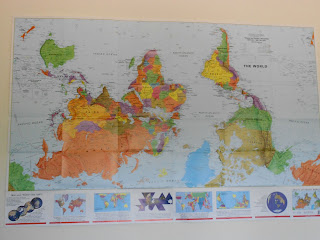Malaria
 |
| Woman with malaria |
500 million clinical cases annually
1.5-3 million deaths annually (largely African infants and young children); 90% of deaths in Africa
5 types of protozoan species; P. falciparum is the worst because of how it quickly creates a density of # in the blood and sequestration in microvasculature (severe malaria)
Transmission
Anopheles mosquito transmits the sporozite through its saliva. This travels to the liver cells and becomes a schizont. The liver cell ruptures and releases thousands of merozoites which infect red blood cells causing all the symptoms and signs of the disease.
| Characteristic | P. falciparum | P. vivax | P. ovale | P. Knowlesi | P. malariae |
| Incubation period (d) | 8-11 | 10-17 or longer | 10-17 or longer | 9-12 | 18-40 or longer |
| Severity of 1’ attack | Severe | Mild-severe | Mild | Mild-severe | Mild |
| Periodicity (h) | / | 48 | 48 | 24-27 | 72 |
| Untreated duration (wk) | 2-3 | 3-8 | 2-3 | unknown | 3-24 |
| Untreated infection | 6-17 mo | 5-7 yr | 12 mo | Not available | 20+ yr |
| Parasitemia (per mm2) | >= 20000 | 10000 | 9000 | Unavailable | 6000 |
| Anemia | Frequent,severe | Mild | Mild | Mod-severe | Mild |
| CNS | Yes, severe | Rare | Rare | possible | Rare |
| Nephritic syndrome | Rare | Rare | No | Probably common | frequent |
Diagnosis: blood smear or rapid antigen detection (RADs) tests but have less accuracy and false positives; also RAD's can be falsely negative in the first 24 hours
P. vivax P. ovale P. malariae P. falciparum P. knowlesi
 |
| Child with malaria |
Acute symptoms: Classical paroxysm (3 stages) lasts 6-10 hours
1.‘Cold’ stage- rigors and shaking
2.‘Hot’ stage – T > 40’; restless, vomiting, convulsions
3.Sweating stage – sleeping
For 3 days possibly asymptomatic, or with headache, cough, myalgias, fever, chills, diarrhea, mild jaundice, vomiting, nausea, anorexia
Chronic symptoms: Anemia, hepatosplenomegaly, weight loss, diarrhea, increased susceptibility to other infections
2’ complications: Burkitt’s Lymphoma, Hyperreactive Malarial Splenomegaly, Quartan malarial nephropathy
 |
| Same child but trying to capture typical way to carry babies |
Pregnancy: low birth weight, fetal distress, premature labor, stillbirth, congenital malaria along with common side effects in the mother of anemia, hypoglycemia, and acute pulmonary edema
Severe malaria is most serious outcome
Cerebral: 20% mortality with retinal hemorrhages, coma, convulsions, focal neurological symptoms. Sequelae can be transient or permanent with hemiparesis, cerebellar ataxia, cortical blindness, hypotonia, mental retardation.
Treatement:
Thanks to Dr. Chris Milner, an English doc who has the most amazing encyclopedia brain of fun facts I'm going to talk a little about the history and making of what is really an incredible treatment for malaria.
Malaria treatment goes back to the 200 BC when Chinese herbalists used the herb artemesia. In the 1970's a Chinese researcher stumbled upon the derivative artemisinin in wormwood and found that it had an amazing ability to clear malarial parasites from the blood. Apparently the herb has been used on and off throughout history as even in the 1840's French troops were using it in fortified wines to treat malaria.
Fun Fact #2: The same family of herbs is used in martinis, so if you've ever had Absinthe, you've had a wee bit of an antimalarial concoction. Even though I've never liked martini's it's an interesting fact they have health benefits in some ways. :)
Now, because of increasing rates of resistance, artemisinin is used in combination treatments or "Artemisinin- Combination Therapy" (ACT).
-Standard treatment
used to be chloroquine at 25 mg/kg for 3 days, but it has had increasing resistance and is no longer used in many parts of world. Additionally, it doesn't work for the hypnozoite stage of the lesser common types of Plasmodium for which primaquine at .5 base, .325 mg/kg dosing is used. Primaquine is an antioxidant contraindicated for G6PD deficient folks.
-Coartem (Artemether/Lumefantrine) at 6 doses of 4 tabs each for 3 days is completely efficacious here and our standard treatment here in Mozambique. The national policy requires a positive rapid antigen test (which can be negative for the first 24 hours) in order to treat.
-Artesunate/Mefloquine is also effective but expensive
-Artesunate/Sulfadoxine-pyrimethane has high resistance and less used now.
-Artesunate/amodiaquine is only effective in West Africa
-In pregnancy: Quinine/Clindamicine in the 1' Trimester after which any standard ACT is okay
Severe Malaria:
-Artesunate IV - decreases relative risk mortality by 35%
-Quinine IV - careful use because hyperinsulin hypoglycemia especially in pregnancy and special renal dosing
-Artemether IM has irregular efficacy
-Quinidine - cardiac monitoring, yes this is an antiarrhythic usually (note its enantiomer cousin quinine usual use in malaria)
-or the ever possible rectal dosing of artesunate
Prophylaxis
-Atovaquone-proguanil (Malarone) - expensive
-Mefloquine - can be used in pregnancy not in neonates, and watch out side effects
-Doxycycline - sun sensitivity, GI side effects, no preggers
-Primaquine- no go preggers or G6PD
-Proguanil - resistance limited
-Chloroquine - no, don't really use this.

















































